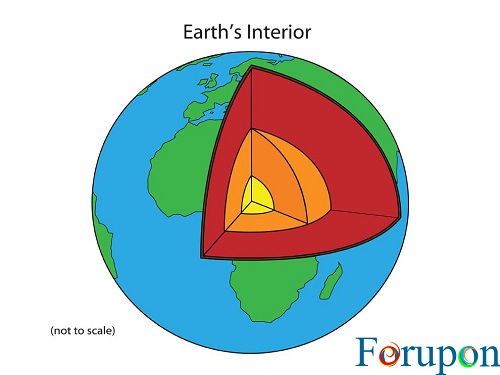Mantle
Mantle Earth: The mantle is the most solid bulk of Earth’s interior. 1The mantle lies between Earth’s dense, super-heated core and its thin outer layer, the crust. The mantle is about 2,900 kilometers (1,802 miles) thick and makes up a whopping 84% of Earth’s total volume.
Earth’s Interior
The Earth is divided into three main layers. The dense, hot inner core (yellow), the molten outer core (orange), the mantle (red), and the thin crust (brown), support all life in the known universe. Click through this gallery to learn more about the mantle and the rest of Earth’s interior.
Earth’s Size
1The mantle is the mostly solid bulk of Earth’s interior. The mantle lies between Earth’s dense, super-heated core and its thin outer layer, the crust. The mantle is about 2,900 kilometers (1,802 miles) thick and makes up a whopping 84% of Earth’s total volume.
Earth’s Interior
Peek inside the Earth with this downloadable poster.
What on Earth is Plate Tectonics
Plate tectonics are dominated by activity in the mantle, from seafloor spreading (where plates are ripping apart from each other) to subduction zones (where plates are crashing into each other.) Download this handy guide from the National Park Service for a great introduction to this monumental process.
Olivine
The rocks that make up Earth’s mantle are mostly silicates—a wide variety of compounds that share a silicon and oxygen structure. Common silicates found in the mantle include olivine, garnet, and pyroxene. This rock is an example of olivine from the mantle. (Some gem-quality versions of olivine may be familiar as peridot.)
Cutaway Earth
The mantle is loosely divided into several layers: the upper mantle, the transition zone, the lower mantle, and D” (D double-prime). The upper mantle itself is divided into two sections. The uppermost, brittle layer of the mantle and crust is known as the lithosphere. The slightly more malleable layer beneath the lithosphere is the mantle’s asthenosphere.
Ringwoodite
The fascinating, mysterious transition zone lies about 410 kilometers (255 miles) to 660 kilometers (410 miles) beneath Earth’s surface. Perhaps the most unusual aspect of the transition zone is the fact that it holds as much water as all the oceans on Earth’s surface. Minerals such as ringwoodite trap a form of water known as hydroxide in their crystal lattices (inset).
Mantle Convection
Mantle convection describes the movement of the mantle as it transfers heat from the white-hot core to the brittle lithosphere. Earth’s heat budget, which measures the flow of thermal energy from the core to the atmosphere, is dominated by mantle convection. Geologists debate whether mantle convection is “whole,” involving the entire mantle, or “layered,” involving distinct movements of the upper and lower mantle. Both theories are displayed in this fantastic graphic.
Mantle Plumes
Beneath the lower mantle is a weird region known as D”, or “D double-prime.” The unpredictable movement of materials in D’’ is influenced by the lower mantle and outer core. The iron of the outer core influences the formation of a diaper, a Lava-Lamp-like feature (intrusion) where fluid material is forced into the brittle overlying rock. The diapir radiates heat and may release a huge, bulging pulse of either material or energy. This energy blooms upward, transferring heat to the lower mantle and transition zone, and maybe even erupting as a mantle plume. Mantle plumes—from their structure to whether they exist at all—are among the most debated subjects in geology.
Drilling to the Moho
The mantle has never been directly explored. In 2005, scientists drilled 1,416 meters (4,644 feet) below the North Atlantic seafloor and claimed to have come within just 305 meters (1,000 feet) of the Moho.
Kimberlite
Many geologists study the mantle by analyzing xenoliths. Xenoliths are a type of intrusion—a rock trapped inside another rock. The xenoliths that provide the most information about the mantle are diamonds. The diamonds themselves are of less interest to geologists than the xenoliths some contain. These intrusions are minerals from the mantle, trapped inside the rock-hard diamond. This gorgeous cross-section of a kimberlite diamond (inset) shows green olivine xenocrysts from the mantle.
Upper Mantle
Asthenosphere
Transition Zone
Lower Mantle
D Double-Prime (D’’)
Mantle Convection
Exploring the Mantle
Seismic Waves
Mantle Maps

The mantle, between the brittle crust and super-dense core, makes up a whopping 84% of Earth’s total volume.
Illustration by Ewalde1, courtesy Wikimedia. CC-BY-SA-3.0
Mantling Conductivity
Interactives
The article was originally published here.


Comments are closed.